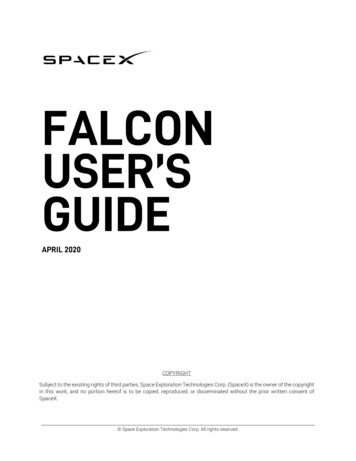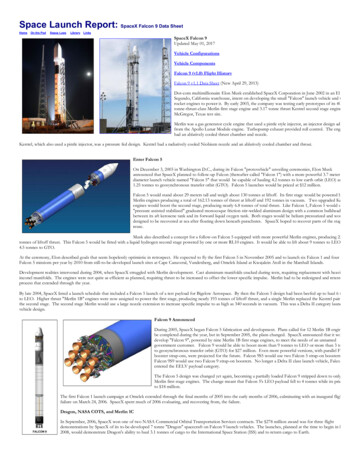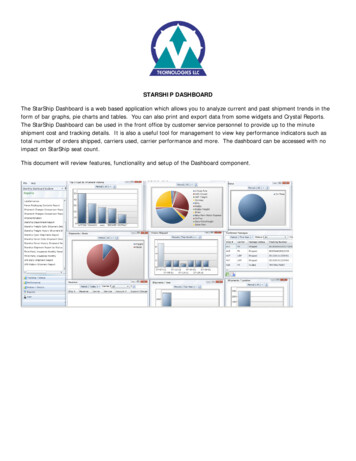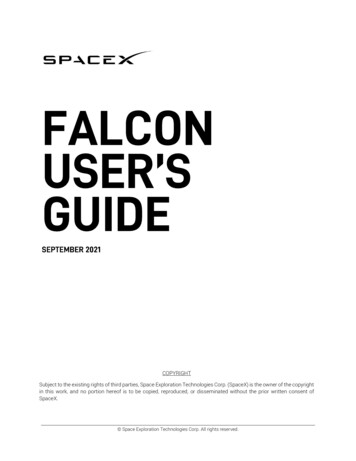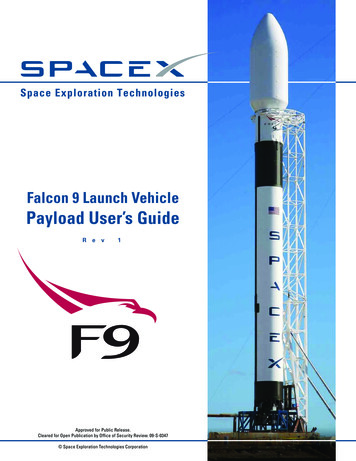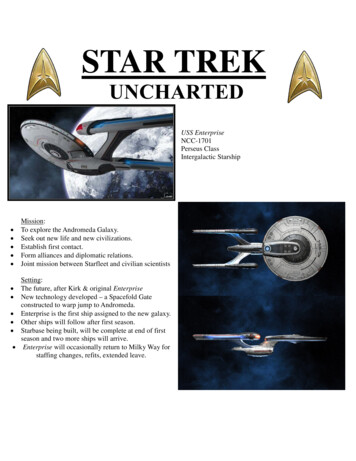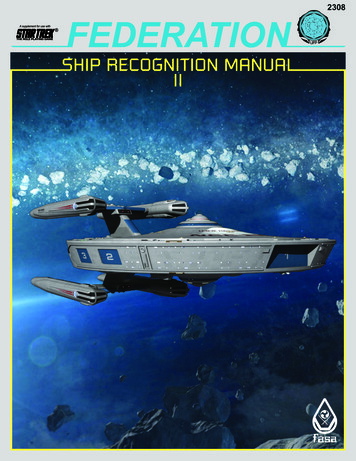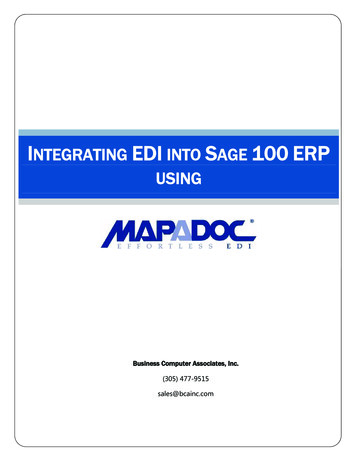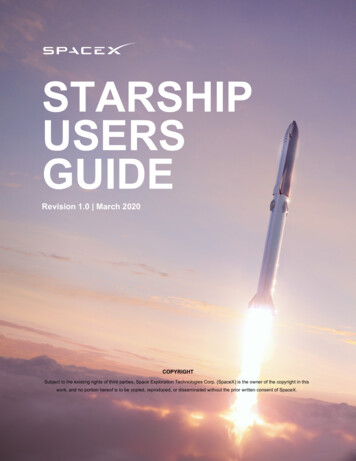
Transcription
STARSHIPUSERSGUIDERevision 1.0 March 2020COPYRIGHTSubject to the existing rights of third parties, Space Exploration Technologies Corp. (SpaceX) is the owner of the copyright in thiswork, and no portion hereof is to be copied, reproduced, or disseminated without the prior written consent of SpaceX. Space Exploration Technologies Corp. All rights reserved.
STARSHIP PAYLOAD GUIDECOMPANY DESCRIPTIONSpaceX was founded in 2002 to revolutionize accessto space and enable a multi-planetary society. Today,SpaceX performs routine missions to space with itsFalcon 9 and Falcon Heavy launch vehicles for adiverse set of customers, including the NationalAeronautics and Space Administration (NASA), theDepartment of Defense, international governments,and leading commercial companies. SpaceX providesfurther support to NASA with the Dragon spacecraft byconducting cargo resupply and return missions to andfrom the International Space Station (ISS). Soon,SpaceX will begin transporting crew to the ISS as well.To offer competitive launch and resupply services,SpaceX has incorporated reusability into the Falconand Dragon systems, which improves vehicle reliabilitywhile reducing cost. The Starship Program nowleverages SpaceX’s experience to introduce a nextgeneration, super heavy-lift space transportationsystem capable of rapid and reliable reuse.STARSHIP PROGRAM OVERVIEWSpaceX’s Starship system represents a fully reusabletransportation system designed to service Earth orbitneeds as well as missions to the Moon and Mars. Thistwo-stage vehicle—composed of the Super Heavyrocket (booster) and Starship (spacecraft) as shown inFigure 1—is powered by sub-cooled methane andoxygen. Starship is designed to evolve rapidly to meetnear term and future customer needs while maintainingthe highest level of reliability.STARSHIP USERS GUIDEStarship has the capability to transport satellites,payloads, crew, and cargo to a variety of orbits andEarth, Lunar, or Martian landing sites. PotentialStarship customers can use this guide as a resourcefor preliminary payload accommodations information.This is the initial release of the Starship Users Guideand it will be updated frequently in response tocustomer feedback.PAYLOAD CONFIGURATIONSStarship crew and uncrewed configurations are shownin Figure 2. The uncrewed Starship allows for thetransport of satellites, large observatories, cargo,refueling tanks or other unmanned assets. Subsequentsections provide an overview of the preliminary volumeand mechanical interfaces available; preliminarypayload environments expected; and the preliminarymass-to-orbit capabilities of Starship. Please contactsales@spacex.com to evaluate how Starship can meetyour unique needs.Figure 1: Starship and Super Heavy Space Exploration Technologies Corp. All rights reserved.1
STARSHIP PAYLOAD GUIDEFigure 3: Starship payload deployment sequencePAYLOAD VOLUMEFigure 2: Starship crew (left) and uncrewed (right)configurationsStarship’s 8 m diameter payload dynamic envelope isshown in Figure 4. This large deployable envelopeallows for the design of novel payloads, rideshareopportunities and entire constellations of satellites on asingle launch. An extended payload volume is alsoavailable for payloads requiring up to 22 m of height.PAYLOAD MECHANICAL INTERFACESPAYLOAD FAIRINGThe standard Starship payload fairing is 9 m in outerdiameter resulting in the largest usable payload volumeof any current or in development launcher.The Starship payload fairing is a clamshell structure inwhich the payload is integrated. Once integrated, theclamshell fairing remains closed through launch upuntil the payload is ready to deploy. An examplesequence of payload deployment is shown in Figure 3.To deploy the payload, the clamshell fairing door isopened, and the payload adapter and payload are tiltedat an angle in preparation for separation. The payloadis then separated using the mission-unique payloadadapter. If there are multiple payloads on a singlemission, a rotating mechanism can be provided toallow each satellite to separate with maximumclearance. Once separation is confirmed and thepayload(s) have cleared the fairing, the payload fairingdoor is closed in preparation for Starship’s return toEarth.Figure 4: Starship payload volume (dimensions in m) Space Exploration Technologies Corp. All rights reserved.2
STARSHIP PAYLOAD GUIDEPAYLOAD MANIFESTINGSatellite customers may be manifested on single ormulti-manifest missions. Customers can bring a singlespacecraft, coordinate their own rideshares for a singleStarship launch, or work with SpaceX to takeadvantage of a multi-manifest launch. Customermissions do not need to wait for co-passengers in orderto fly.commanded after integration into the fairing withoutfacility located payload EGSE. This covers final prelaunch events in the processing facility and on thelaunch pad, and some of these electrical interfacesmay continue to be available in-flight. Contactsales@spacex.com for more information or otheroptions.The unique and large geometry of the Starship payloadbay also opens new opportunities for payloadintegration. For payloads requiring additional structuralsupport, Starship has the ability to mount supportsalong the sidewalls or nose to interface with trunnionstyle interfaces on the payloads, similar to thoseemployed on NASA’s Space Shuttle orbiters. Whenlarge payloads are co-manifested on Starship, they aregenerally mounted side-by-side on the payloadadapter.This reduces technical and mpared to stacked configurations.Utilizing strong heritage and lessons learned from thedevelopment of the Falcon 1, Falcon 9 and FalconHeavy launch systems, SpaceX is designing Starshipand Super Heavy to provide as benign of a payloadenvironment as possible. SpaceX will ensure thatStarship environments meet or improve upon those ofthe Falcon Heavy launch system. To aid in the designof space vehicles capable of flying on Starship,SpaceX is providing the following preliminary payloadenvironments.Example single-mission manifests:LOADS 1-3x geosynchronous telecom satellite(s)Full constellation of satellites on a singlemission1-2x geosynchronous telecom satellites plusrideshare system of small satellitesIn-space demonstration spacecraft that remainsintegrated with Starship and returns to EarthCargo and crew configurationsENVIRONMENTSSpaceX is designing Starship to ensure thatacceleration environments are well within industrystandard levels. During flight, the payload willexperience a range of axial and lateral accelerations.Both the Super Heavy and Starship engines can bethrottled to help maintain launch vehicle and payloadacceleration limits.PAYLOAD ADAPTERSThe Starship payload attach fitting is designed toaccommodate standard payload interface systems insingle- or multi-manifest configurations. SpaceX willeither provide and integrate a payload adapter andclampband separation system or will integrate anadapter and separation system provided by thecustomer. As a baseline, Starship is compatible withheritage Falcon 937-mm, 1194-mm, 1666-mm and2624-mm clampband interface requirements, includingthe ability to host multiple payloads side by side giventhe large diameter available. For customers withalternative interface requirements, SpaceX has a widebreadth of experience designing and manufacturingnon-standard adapters and separation systems.PAYLOAD ELECTRICAL INTERFACESStarship will replicate common payload power and datainterface standards on the flight vehicle in lieu t (EGSE) for final pre-launch operations. Thiswill allow the payload to be powered, monitored, andFigure 5: Payload maximum design load factorsThe maximum expected design load factors for a singlepayload mission launching on Starship are shown inFigure 5. Actual payload dynamic loads, accelerations,and deflections are a function of the dynamic couplingbetween Starship and the payload. These loads can beaccurately determined via a coupled loads analysis.For payload specific loads or rideshare loadsassessments, contact sales@spacex.com. Space Exploration Technologies Corp. All rights reserved.3
STARSHIP PAYLOAD GUIDEACOUSTICSSHOCKDuring flight, the payload will be subjected to a rangeof acoustic environments. Levels are highest duringliftoff and transonic flight, due to acoustic andaerodynamic excitations. The maximum expectedpayload acoustic environments are shown in Table 1and Figure 6 in one-third octave bands. Contactsales@spacex.com for mission specific low frequencyacoustic assessments.SpaceX is designing Starship to have benign shockenvironments. Stage separation and payload fairingdoor opening will generate negligible shockenvironments at the payload interface. Consequently,the maximum shock environment is typically due to thepayload separation system selected for the mission.Typical maximum shock levels at the payloadseparation plane induced by payload separationsystems are provided in Table 2 00012501600200025003150400050006300800010000OASPL (dB)Acoustic Limit Levels1/3 ble 1: Payload acoustic environment (1/3 octave)Frequency(Hz)Shock SRS(g-peak)1002010001000100001000Table 2: Typical payload separation-induced shock atthe payload separation planePAYLOAD INTEGRATIONSpaceX is initially planning for two launch sites for theStarship vehicle: Kennedy Space Center LC-39A 28.6082 Nlatitude, 80.6041 W longitudeBoca Chica launch pad 25.9971 N latitude,97.1554 W longitudeFor payloads requiring return to Earth, landing sites arecoordinated with SpaceX and could include KennedySpace Center, FL or Boca Chica, TX.Payloads are integrated into the Starship fairingvertically in ISO Class 8 (Class 100,000) cleanrooms.Then the integrated payload stack is transferred to thelaunch pad and lifted onto the Starship vehicle, whilemaintaining the same vertical orientation throughoutthe entire process. Conditioned air is delivered into thefairing during encapsulated ground processing while inthe processing facility and on the launch pad.PAYLOAD SEPARATIONSpaceX provides in-flight commanding and monitoringof the payload separation system(s). Starship canperform 3-axis attitude controlled or spin-stabilizedspacecraft separation. Note that certain spacecraftseparation maneuvers may reduce available payloadvolume. Collision avoidance maneuvers will beperformed as required.Figure 6: Payload acoustic environment (1/3 octave) Space Exploration Technologies Corp. All rights reserved.4
STARSHIP PAYLOAD GUIDEPERFORMANCECREW CONFIGURATIONThe Starship and Super Heavy system offerssubstantial mass-to-orbit capabilities. At the baselinereusable design, Starship can deliver over 100 metrictons to LEO. Utilizing parking orbit refueling, Starshipis able to deliver unprecedented payload mass to avariety of Earth, cislunar, and interplanetarytrajectories. A summary of available Starshipcapabilities is provided in Table 3 below. The singlelaunch mass-to-orbit assumes no orbital refueling ofStarship. The maximum mass-to-orbit assumesparking orbit propellant transfer, allowing for asubstantial increase in payload mass. Theseperformance numbers assume full Starship reuse,including Super Heavy return to launch site. Forperformance estimates to a specific orbit, pleasecontact sales@spacex.com.SpaceX was founded with the goal of making life multiplanetary. The Starship program is realizing this goalwith the crew configuration of Starship. Drawing onexperience from the development of Dragon for theCommercial Crew Program, the Starship crewconfiguration can transport up to 100 people from Earthinto LEO and on to the Moon and Mars. The crewconfiguration of Starship includes private cabins, largecommon areas, centralized storage, solar stormshelters and a viewing gallery.OrbitMass-to-OrbitSingle LaunchLEO1100 Mass-toOrbit PropTransfer (t)100 GTO221100 Lunar SurfaceN/A100 Mars SurfaceN/A100 Figure 8: Starship Crew Configuration1Up2Assumesto 500-km circular orbit at up to 98.9-deg inclination185 x 35,786 km orbit at 27-deg inclination with 1800 m/s V to goTable 3: Expected Starship PerformanceCARGO CONFIGURATIONStarship was designed from the onset to be able tocarry more than 100 tons of cargo to Mars and theMoon. The cargo version can also be used for rapidpoint-to-point Earth transport. Various payload bayconfigurations are available and allow for fullyautonomous deployment of cargo to Earth, Lunar, orMartian surfaces with one example shown in Figure 7.ADDITIONAL CAPABILITIESFully-reusable Starship and Super Heavy systems areexpected to allow for space-based activities that havenot been possible since the retirement of the SpaceShuttle and Space Transportation System or havenever been possible before. With a fully reusableStarship, satellites can be captured and repaired inorbit, returned to Earth, or transferred to a newoperational orbit. For more information on additionalcapabilities or to conceptualize new ideas, pleasecontact sales@spacex.com.Figure 7: Cargo Starship on Lunar Surface Space Exploration Technologies Corp. All rights reserved.5
STARSHIP PAYLOAD GUIDE Space Exploration Technologies Corp. All rights reserved. 1 COMPANY DESCRIPTION SpaceX was founded in 2002 to revolutionize access
